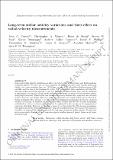Long-term stellar activity variations and their effect on radial-velocity measurements
Abstract
Long-term stellar activity variations can affect the detectability of long-period and Earth-analogue extrasolar planets. We have, for 54 stars, analysed the long-term trend of five activity indicators: log R′HKRHK′, the cross-correlation function (CCF) bisector span, CCF full-width-at-half-maximum, CCF contrast, and the area of the Gaussian fit to the CCF; and studied their correlation with the RVs. The sign of the correlations appears to vary as a function of stellar spectral type, and the transition in sign signals a noteworthy change in the stellar activity properties where earlier type stars appear more plage dominated. These transitions become more clearly defined when considered as a function of the convective zone depth. Therefore, it is the convective zone depth (which can be altered by stellar metallicity) that appears to be the underlying fundamental parameter driving the observed activity correlations. In addition, for most of the stars, we find that the RVs become increasingly red-shifted as activity levels increase, which can be explained by the increase in the suppression of convective blue-shift. However, we also find a minority of stars where the RVs become increasingly blue-shifted as activity levels increase. Finally, using the correlation found between activity indicators and RVs, we removed RV signals generated by long-term changes in stellar activity. We find that performing simple cleaning of such long-term signals enables improved planet detection at longer orbital periods.
Citation
Costes , J C , Watson , C A , de Mooij , E , Saar , S H , Dumusque , X , Cameron , A C , Phillips , D F , Günther , M N , Jenkins , J S , Mortier , A & Thompson , A P G 2021 , ' Long-term stellar activity variations and their effect on radial-velocity measurements ' , Monthly Notices of the Royal Astronomical Society , vol. Advance Article . https://doi.org/10.1093/mnras/stab1183
Publication
Monthly Notices of the Royal Astronomical Society
Status
Peer reviewed
ISSN
0035-8711Type
Journal article
Description
Funding: ACC acknowledges support from STFC consolidated grant ST/R000824/1. This project has received funding from the European Research Council (ERC) under the European Union's Horizon 2020 research and innovation programme (grant agreement SCORE No 851555).Collections
Items in the St Andrews Research Repository are protected by copyright, with all rights reserved, unless otherwise indicated.

